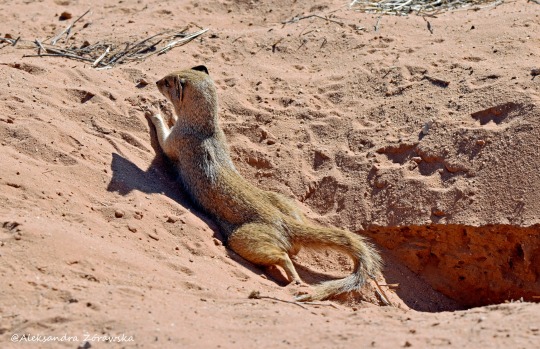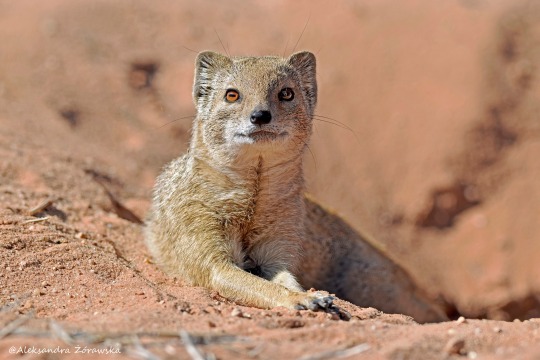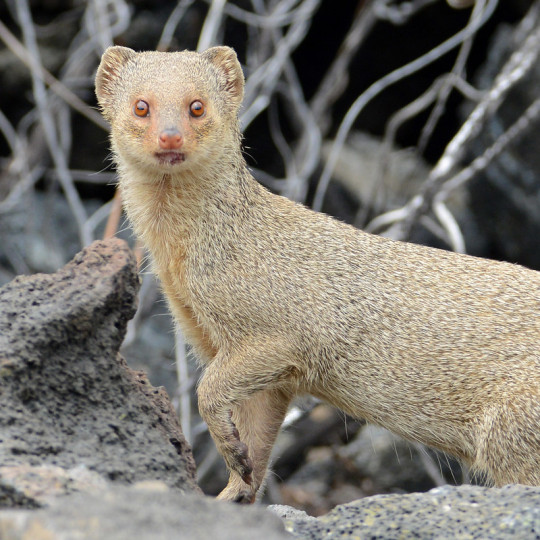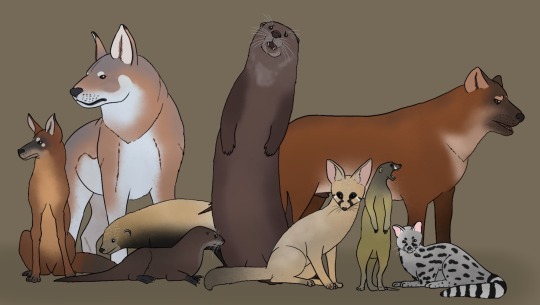#herpestidae
Text




Yellow Mongoose (Cynictis penicillata), family Herpestidae, Kgalagadi Transfrontier Park, Northern Cape, South Africa
photographs by Aleksandra Zorawska
1K notes
·
View notes
Text


White-tailed mongoose (Ichneumia albicauda)
Photos [1, 2] by Josh More
2K notes
·
View notes
Text
Uncharismatic Fact of the Day
Banded mongoose females love drama. More specifically, they love to cause it; when mating season rolls around, females from one gang will start a fight with another gang. Then, when most of the males are thoroughly engaged, the females will sneak off to mate with any available rival males. Afterwards, they return to their original group, where the unsuspecting males help raise the pups as their own.

(Image: A banded mongoose mum and her pups (Mungos mungo) by Alan Horstmann via iNaturalist)
If you like what I do, consider leaving a tip or buying me a ko-fi!
#banded mongoose#Carnivora#Herpestidae#mongooses#cat-like carnivorans#carnivores#mammals#uncharismatic facts
151 notes
·
View notes
Text

A small Indian mongoose (Urva auropunctata) in Hawai'i
by matt "smooth tooth" knoth
#small indian mongoose#mongooses#urva auropunctata#urva#herpestidae#carnivora#mammalia#chordata#wildlife: hawai'i#wildlife: usa#invasive species
150 notes
·
View notes
Photo

Indian Grey Mongoose
59 notes
·
View notes
Text

21 notes
·
View notes
Photo

Southern Yellow Mongoose
Cynictis penicillata ssp. penicillata
Western District, South Africa
-33.443198, 25.793184
by jandutoit
#mongoose#southern yellow mongoose#yellow mongoose#south africa#herpestidae#family herpestidae#cynictis#genus cynictis#south african fauna#mongooses#photography#m
145 notes
·
View notes
Text
love randomly clicking on the 'talk' section on wikipedia to discover that in 2007 the page claimed mongooses were vampires

7 notes
·
View notes
Text
um

10 notes
·
View notes
Text



They call this thing the Eagle and fly around in it.
But it really looks more like some kind of Mustelidae...

#space 1999#space 1999 eagle#spaceship#yes i know mongooses are Herpestidae#this is a very specific and time-sensitive injoke
26 notes
·
View notes
Text

After the Anthropocene mass extinction Earth lost a great portion of its former biodiversity, with only adaptable and (usually) small critters surviving, and thus inheriting a planet devoid of any competition from their bigger and more specialised relatives.
As the climate stabilised the plants started regaining their former diversity, allowing the herbivores to do so aswell, and the carnivores that preyed on them too.
As of now the main predatory clade of Africa are the felids, ranging from the big lions and leopards to the small wildcats. After the mass extinction only four species of them survived: the African golden cat, the African wildcat, the black-footed cat and the sand cat (plus the remaining jungle cat and feral cat populations that fused with the African wildcats).
These survivors were quick to fill the empty niches and diversified rapidly.
In ten million years the black-footed and sand cat remained quite small, only diversifying in a handful of desert and savannah species that hunted rodents, shrews, birds and reptiles. The African wildcat, on the other hand, other than for a myriad of jungle hunters, evolved into two directions: medium sized ambush predators, like the semi-arboreal Gorbofelis sorayae or Plejadkat, and pursuit predators, like the cursorial Celerailurus brevis or Kortoor-kat, that unlike cheetahs still retains retractable claws and remains a way more effective and successful hunter.
The African golden cat, being the biggest extant predator on the continent, became its new apex predator, quickly growing in size along with its prey, and evolving into a lineage of big ambush predators, culminating in the enormous Ajubaleo sankarai or Sankara’s cat, almost as tall as a man and capable of taking down the rhino sized hyraxes and antelopes of the Epigene.

As cats diversified, other African carnivorans did too. Like in modern times, the second most dominant carnivoran clade are the canids, that will remain as such in Africa throughout the Epigene. The two biggest African dogs are the broad-faced dog or Lycothous latios, a big scavenger descended from jackals capable of crushing bones that bullies bigger predators away from their kill; and the African red wolf or rooiwolf (Afrolupus fulvus), a cursorial pack hunter descended from African wolves that tires its prey to death.
From foxed evolved the laangvos or Alopecocyon macrypus, a pale fox descendant that specialises in hunting small rodents, shrew and moles; and its close relative the Serengeti fox (Afrovulpes excavans), almost identical to its ancestor.
Of all the African otters only the spotted-neck one survived, with both basal forms like the Metahydra cancrivora, and giant ones, like the Gigantohydra leonina, capable of reaching a grown man’s shoulders when standing up and capable of competing with crocodiles in hunting antelopes drinking at the riverside.
Other mustelids survived too, although usually retaining their ancestral bodyplans, like the honey badger, whose African descendant, the golden badger (Mellivoroides chrysus), who retained its strong aposematic coloration only on its rearside, developing a more camouflaging golden coloration on the front to better ambush both small and “big” prey.
Out of the feliforms both Viverridae and Herpestidae survived in the savannah, usually remaining pretty unchanged, except for the meerkats (Neosuricata acutidens) who became facultatively eusocial like the naked mole-rats and developed a venomous bite.
#spec evo#spec bio#speculative evolution#speculative biology#future earth#future evolution#worldbuilding#artwork#digital art#epigene period
43 notes
·
View notes
Text

Common Dwarf Mongooses (Helogale parvula), family Herpestidae, Serengeti National Park, Tanzania.
photograph by Ren Schiffer
318 notes
·
View notes
Text

Yellow mongoose (Cynictis penicillata)
Photo © James Tompkins
2K notes
·
View notes
Text
Uncharismatic Fact of the Day
For some animals, a snake’s hiss is worse than its bite. Mongooses, honey badgers, hedgehogs, and pigs are all immune to snake venom. All these species have independently evolved this trait, which is a result of a mutation which prevents snake venom α-neurotoxin from binding to their cell receptors.

Image: A common slender mongoose (H. sanguineus) by Matthew Thayer
#mongoose#honey badger#hedhehogs#badgers#pigeons#carnivora#Herpestidae#carnivores#Mustelidae#mustelids#Eulipotyphla#Erinaceidae#Artiodactyla#suidae#even-toed ungulates#ungulates#mammals#uncharismatic facts
118 notes
·
View notes
Text

A pair of meerkats (Suricata suricatta) relax in Toronga Zoo, Sydney, Australia
by John Turnbull
#meerkat#mongooses#suricata suricatta#suricata#herpestidae#carnivora#mammalia#chordata#captive animal#toronga zoo
63 notes
·
View notes
Photo

Indian Grey Mongoose
19 notes
·
View notes